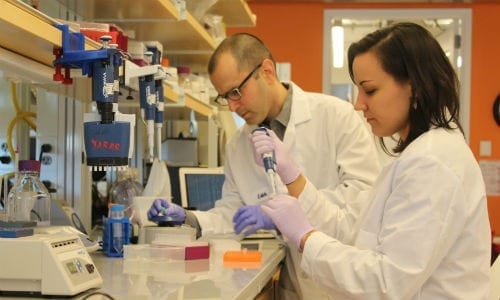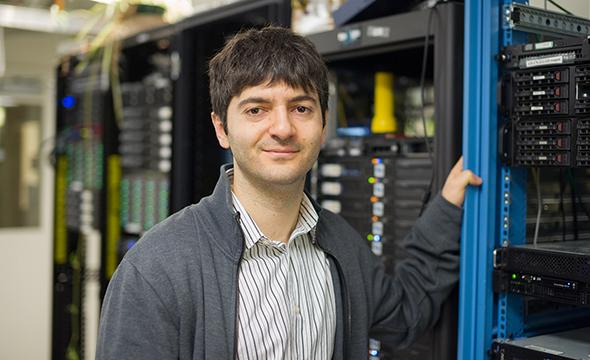
“This new chemistry allows for bond constructions that have previous been simply unimaginable,” said Baran.
Chemists at The Scripps Research Institute (TSRI) have invented a powerful method for joining complex organic molecules that is extraordinarily robust and can be used to make pharmaceuticals, fabrics, dyes, plastics and other materials previously inaccessible to chemists.
“We are rewriting the rules for how one thinks about the reactivity of basic organic building blocks, and in doing so we’re allowing chemists to venture where none has gone before,” said Phil S. Baran, the Darlene Shiley Chair in Chemistry at TSRI, whose laboratory reports the finding on functionalized olefin cross-coupling this week in Nature.
With the new technique, scientists can join two compounds known as olefins to create a new bond between their carbon-atom backbones. Carbon-to-carbon coupling methods are central to chemistry, but until now have been plagued by certain limitations: they often fail if either of the starting compounds contains small, reactive regions known as “functional groups” attached to their main structure. They also frequently don’t work well in the presence of “heteroatoms”—non-carbon atoms such as nitrogen, oxygen and iodine—despite the importance of these types of atoms in chemical synthesis.
The new method is what chemists call “mild,” meaning that it doesn’t require the use of extreme temperatures or pressures, nor harsh chemicals. As a result, portions of the building blocks used that are particularly fragile remain unaltered by the reaction.
“Functional groups that would be destroyed by other cross-coupling methods are totally unscathed when using our method,” said Julian C. Lo, a graduate student who was a co-lead author of the report with Research Associate Jinghan Gui.
Natural Products as Launching Pad
The innovation arose from a Baran laboratory project to synthesize natural compounds found in traditional Chinese medicines.
Read more: Scientists Open New Frontier of Vast Chemical ‘Space’
The Latest on: New chemistry
[google_news title=”” keyword=”New chemistry” num_posts=”10″ blurb_length=”0″ show_thumb=”left”]
via Google News
The Latest on: New chemistry
- Anne Hathaway, Nicholas Galitzine on their chemistry in May-September rom-comon April 28, 2024 at 9:26 am
Or was their potent chemistry already there by the time the cameras started rolling? READ: Anne Hathaway almost played ‘Barbie’ “I think the chemistry was already there,” Nicholas asserted. “I mean, ...
- New mechanochemical process revolutionizes lithium extractionon April 28, 2024 at 5:36 am
R esearchers at the Critical Materials Innovation (CMI) Hub, supported by the US Department of Energy’s Ames National Laboratory, are pushing the boundaries of chemistry and lithium extraction with a ...
- WATCH: Reed Chumley speaks on defensive comfort, chemistry with Wetherholton April 27, 2024 at 4:40 pm
West Virginia University baseball infielder Reed Chumley spoke with the media Saturday night following the Mountaineers 5-2 win over Baylor at Kendrick Family Ballpark in ...
- Breakthrough in Sodium Battery Chemistry Promises Lower Costson April 27, 2024 at 12:00 pm
A new mass synthesis process for sodium-containing sulfides could make all-solid-state sodium batteries more affordable and safer than lithium-ion batteries.
- New water quality lab opens to help monitor riveron April 27, 2024 at 11:50 am
A new facility helping to monitor the water quality of the River Wey in Surrey has opened. The Water Rangers Community Water Lab is at the new base of Zero Carbon Guildford, in the High Street. It ...
- Scientists are shaking up lithium extraction with a different kind of chemistryon April 27, 2024 at 5:19 am
When people think of chemistry, the image that typically comes to mind is a variety of colored liquids in beakers, flasks, and test tubes in a lab. But in actual practice, chemistry can involve ...
- Yoneda Labs raises $4M from Khosla Ventures to build the ‘OpenAI for chemistry’on April 26, 2024 at 4:00 pm
Yoneda Labs raised $4 million from Khosla Ventures to build a foundation model for chemists to help streamline the drugmaking process.
- Lakers chemistry may have been broken in 11th straight loss to the Nuggetson April 26, 2024 at 2:51 pm
The Los Angeles Lakers failed to win Game 3 of the Western Conference Quarterfinals against the defending NBA champion Denver Nuggets on Thursday night. As such ...
- How Nikki DeLoach Ups Chemistry With Andrew Walker in New ‘Curious Caterer,’ Gets Out of ‘Buddy’ Zoneon April 26, 2024 at 12:16 pm
Allister Foster Nikki DeLoach and Andrew Walker’s chemistry in Hallmark's Curious Caterer franchise is an undeniable slow burn, which means it’s not always easy to maintain. “You try to find that ...
- Ronan Farrow sees ‘commonality’ between Weinstein, Trump caseson April 26, 2024 at 11:11 am
Author and journalist Ronan Farrow says he sees “commonality” between the legal cases former President Trump faces and that of disgraced Hollywood mogul Harvey Weinstein. “There ...
via Bing News










